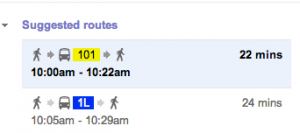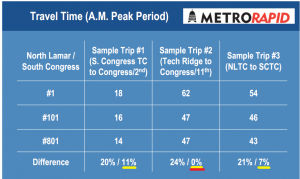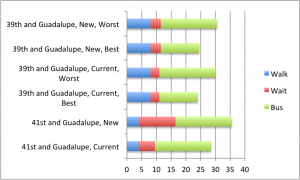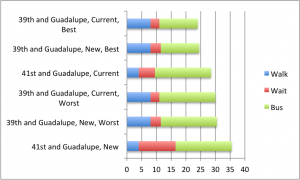Having seen somebody very recently and very approvingly point to this somewhat credulous piece on the Austin Post as “a breakdown” of MetroRapid, and having one of my rare crackplog opportunities (i.e. on a plane), I’ll try to make this brief and use a couple of simple examples.
(Edit: I had a LOT of trouble with an interaction between the javascript in the wordpress composition page and the plane’s wifi; this is best viewed as a first draft or part one).
background
First, remember: Unlike with MetroRapid on Burnet and S Lamar, MetroRapid on Lamar/Guadalupe/SouthCongress is replacing an existing limited-stop service which already runs with decently high frequencies. In other words, we live in a world where the 101 already exists. The change is not, as it is on the 3 corridor, giving up shorter walks in return for higher frequencies and higher speeds; as you will see below, you’re giving up shorter walks AND higher frequencies for no actual improvement in speed.
today’s example: a really good looking guy who happens to live near 42nd and avenue b
Example 1: Let’s call this guy “Precisely Mike Dahmus”, because he’s exactly me. Imagine I worked downtown at 6th and Congress instead of in the evil soul-sucking wasteland across from Westlake High.
If I were to walk from 42nd and Avenue B (near my house) to Guadalupe to take the 1, or 101, today, I’d have choices like this at 8:00 in the morning:

Notice that the 101 isn’t much faster than the 1, overall, because it takes 4 minutes longer to walk to 39th and Guadalupe (where the MetroRapid stop is currently under construction and where the 101 stops today) than it does to walk to 41st and Guadalupe (a 1L/1M stop, but not a 101 or MR stop). The bus is 6 minutes faster downtown if you only consider time on the bus (I used 6th/Congress for this comparison).
What’s the change when MetroRapid is added? Well, half of the 1L/1M trips at 41st/Guadalupe go away; and half of the 1L/1M trips at 39th/Guadalupe also go away (obviously). The MetroRapid route runs every ten minutes during peak times, which sounds good, but remember that the last time I explored this, I showed that the combination of 1 and 101 actually runs more often today than the future combination of 1 and MR will run. I was going to do a pretty picture here with some more screen grabs, but the internet on the plane is not cooperating well with the wordpress composition screen, so I’ll just have to spell it out:
Today, in peak hours, the stop at 41st and Guadalupe gets 5 or 6 1L’s or 1M’s every hour (varies depending on which 60 minute window you choose). The stop at 39th and Guadalupe gets the same 5 or 6 1L/1M buses and 3 or 4 101s. (The example in the link above had 5 1s and 4 101s for a total of 9 buses). Note that at this stop, today, your rational action if you care most about getting to your destination as soon as possible is to get on the first 1 or 101 that shows up because the time savings of 4 minutes (101 being 4 minutes faster than the 1) is less than or equal to the expected wait time for the next bus to arrive (whether or not it will be a 101!). Yes, even if the 101 is faster!
Of course, at 41st and Guadalupe, you’re going to get on the first 1L or 1M you see.
Now, fast-forward to when MetroRapid opens. Capital Metro has said the 101 is gone, replaced with 6 MetroRapids per hour (one every ten minutes). Either the 1L or the 1M is slated to be eliminated, so the 5 or 6 buses per hour changes to 2 or 3. At 41st/Guadalupe, your calculus is now quite different – whereas before you never had longer than 10-12 minutes to wait for the next 1, you may now have 20-25 minutes to wait; and it may make sense to walk down to 39th to pick up the MetroRapid. But this is not an improvement for old Mike! Unlike many of the people on the Burnet/SLamar corridor, he currently has a choice between the 1 and the 101 which is roughly the same – now he’s forced to walk further to the replacement to the 101 because somebody took away half the 1s. The new trip is no faster than his 101 option is today.
Don’t believe me? Look at 39th/Guadalupe in the new order. You’ve got 2-3 1s, same performance characteristics as today; and you’ve got 6 MetroRapids, same performance characteristics as today’s 101 (by Capital Metro’s own admission!):

At 39th/Guadalupe, you gave up between 9 and 11 trips per hour, which had similar overall expected time-to-destination (combination of existing 1 and 101); and you got between 8 and 9 trips per hour (2-3 1s that remain; 6 MetroRapids). And again, I don’t know how often I can emphasize this before people get it, the faster MetroRapid trips aren’t any faster than the 101s that run today.
What about truly frequent service?
One of the ways to think about this is that the time you really spend on transit is a combination of walk+expected wait+travel time, and that transit can only be truly useful when it’s frequent enough that you don’t have to look at a schedule, as Capital Metro has claimed will be the case with MetroRapid (even though, as you can see above, there are problems with this claim).
Jarrett Walker at Human Transit (somebody please remind me to link this later when I have a better connection) has said that when dealing with frequent service, as both the before and after are by Austin’s standards, you should consider the “wait” to just be “half of the headway”, i.e., if you walk out at random to the bus stop, you’re going to wait, on average, half of the scheduled time between buses. Let’s put that to the test.
Today, the Mike example above has the following choices:
- Go to 41st/Guadalupe (4 minute walk).
- Wait for bus (half headway rule says there are 5-6 buses per hour for a headway of 11 minutes; half headway is 5.5 minutes).
- Travel on bus (19 minutes).
The total expected time for “show up and go”, which, again, is how we’re supposed to judge truly frequent service, is 28.5 minutes. Not bad compared to a car drive of 10 minutes, trying to find parking for 5 minutes, and a likely longer walk from parking than from the bus stop!
Mike’s choices at 39th/Guadalupe, if he chooses to take the longer walk to get a chance to ride the 101, are a walk of 8 minutes; a half-headway wait of 3 minutes (9-11 buses per hour); travel time of 13 minutes on the bus for a total expected time of 24 minutes. Note, actually a little faster, in the “show and go” method, compared to staying at 41st/Guadalupe! If you can hack the extra walk, this is the way to go (and this meshes with why MetroRapid is an improvement on Burnet and S Lamar, where no existing express service exists!)
Now, using same methodology for the future; “show and go” at 41st/Guadalupe changes to 2-3 buses per hour, so we get a total expected time of: 4 minutes for the walk, 12.5 minutes for the wait (headway now 20-30 minutes); and the same 19 minutes bus time, adding up to 35.5 minutes. Not a credible alternative to the car any more.
What about going down to 39th/Guadalupe? Same as two paragraphs back except half-headway changes to 3.5 minutes (8.5 trips per hour; half headway). Total expected time is now: 24.5 minutes.
But wait, you say; I’ve used the MetroRapid travel time even though I’m using half-headways that count the 1L and 1M. Yes, yes I am; if we’re doing show-and-go, that’s the way we have to do it (because as we discussed before, once a bus shows up and I’ve already waited N minutes, the rational decision is to get on it whether it’s a local or a limited – because the wait till the next one is actually longer than the expected travel time savings). Is this unfair? Yes, it’s unfair, but unfair mainly in Capital Metro’s favor, since in the equations above I’m assuming all of the buses travel as fast as the current 101!. The image below breaks it out a bit further to explain what happens in the various scenarios. “Best” means you showed up at 39th/Guadalupe and the next bus was a 101; “Worst” means it was a 1.
Hmm. A little difficult to pick out. Let’s sort from best to worst and re-display.
So even with the investment of tens of millions of dollars into MetroRapid, the hypothetical in reality exactly real me gets zero benefit from the project, even in “show and go mode”.
I’ll be back with more use cases later.
KEY POINTS
When somebody says “it’s faster”, it should probably actually be faster. In no way can you reasonably describe MetroRapid on this, by far most important, stretch of corridor as “faster”. MetroRapid may gain a few minutes if you come from the South Transit Center into downtown, which a few people actually do; and even more if you go from South Transit Center to North Transit Center, which nobody actually does, but for the key stretch (you know, the one where rail is an issue being discussed right now), MetroRapid is not any faster, at all, in any way, shape, or form.
When somebody says “it’s more frequent” (as almost everybody has), it should probably actually be more frequent. This isn’t as egregious a falsehood as the speed one, but it’s still incredibly disingenuous. Yes, MetroRapid is running a little more often than the existing 101 whose speed and reliability it will be unable to beat, but Capital Metro intends to pay for this by cutting local buses along the same route which are often a better choice for passengers. Overall frequency, counting all reasonable options, is not going up; it is going DOWN.

